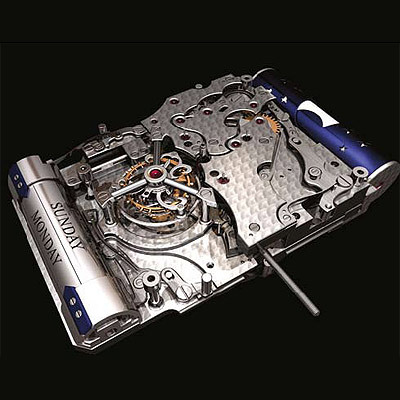I usually have one of my large books about watches on the go in the dining room, where I read snippets from it almost every day. Now, I have three magazines on top of the book and I am going through those a bit at a time. One of the mags is a copy of "International Watch" dated August 2008, and in this thickish issue are 64 pages of new watches straight from 2008 Baselworld. These timepieces are a mixed bunch, and some of them are relatively inexpensive. In the higher price brackets we find names that we know and love, partly because time and the performance of the watches has told a satisfactory story. However, also among the higher price levels we find relatively unknown watch companies producing wild, weird and wonderful timepieces that are deliberate statements, not only about quality and complex watchmaking but also about the wealth and status of the individual final customer. Sometimes, these watches are made in tiny editions, and so do not have safety in numbers that can be a means of checking quality and reliability, and the incredible complications that some of these watches feature are surely at risk of proving to be unreliable. Indeed, in a watch where diamonds or other precious stones are encrusted on the case or bracelet, what guarantee does the customer have that they are not going to start losing gemstones in the wearing of their watch.
A watch that exemplifies the problems I am trying to elucidate is the Chapter One project by new watchmaking company, Maitres du Temps (curcumflex on the 'i'). The watch is featured in the August 2008 International Watch magazine, and we find that the Chapter One timepiece is a tonneau-shaped watch containing a number of complications, the most difficult being the use of rollers - one at either end of the watch - which individually show the moon phase and the day of the week. Even without this tenhnique, the watch is complex enough - being the world's first combination of a tourbillon movement with monopusher column wheel chronograph, retrograde date and retrograde GMT. The case of the Chapter One has no less than 100 components, and the company used elements of supercar design in their creation of this watch. The new watch in its first phase cost US400,000.
The Chapter One timepiece by Maitres du Temps (pic from content.luxurybazaar.com):

The inner details of the Chapter One watch (pic from mywatch.ru):

This watch does receive quite a write-up in the 2008 magazine, perhaps rightly so, and I am not here to dampen down the enthusiasm of those who wish to spend the necessary sum of money to buy one. My only point concerns the question of whether buyers of these watches really do receive good value for money in terms of a watch that is reliable and durable and is able to stand the tests we all put our watches to when we wear them. If I buy a Rolex or an Omega then I know that the watch has behind it many years of proven technology behind it, and a staffed company that has eyes to sort out preliminary difficulties. Because an Omega or a Rolex will generally be made in some quantity, a certain reliability will have slowly been built into the design.
In addition to reliability within the body and movement of the new "masterpieces" by often small and relatively new watch companies, there is also the question of how well external embellishment stands up to swear and tear. One of the excessively bejewelled watches from 2008 Baselworld was the Armaan Watches Spectrum model. The watches are made and designed in Swizerland but the diamonds used are supplied by the Bhansaali family, owners of the brand and also of one of India's largest diamond mines. The Spectrum is certainly eye catching - perhaps verging on "gross") but whoever wears it will need to keep an eye on all those jewels, and what guarantee do the customers have as to how well the gens are set to avoid loss or damage. One bit of reliability that is built in to the watch is a Swiss quartz movement - sorry but you still have to pay over US&4,000 for the privilege.
Tha Armaan Spectrum, powered by a Swiss quartz movement (pic from portalexportfiles.com):

In looking at very expensive watches that veer away from the well trodden road of more conventional design and manufacture, I do wonder how the question of a guarantee is discussed between seller and buyer. I suppose if you are well-off enough then these questions may seem a bit "indelicate." However, surely all companies making highly complex and elaborately decorated timepieces should have enough confidence in their products to expect them to work unhindered by faults for many years. It's just a whimsical consideration I had while looking through the International Watch Magazine and remembering that the august 2008 issue was published just as the Banking crisis and economic crisis was about to hit the States and Europe.
















